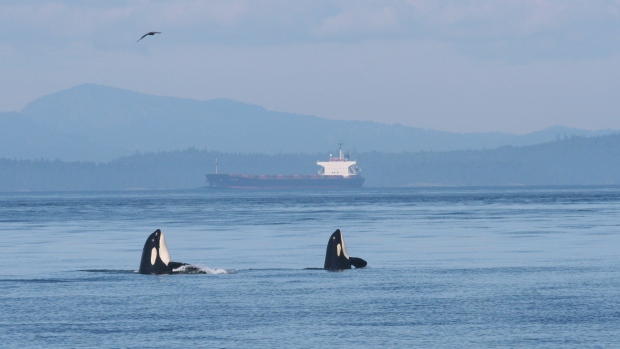The worlds oceans are becoming louder and louder as we search for more oil and gas by undergoing seismic testing, as well as increasing boat traffic to keep up with worldwide shipping demands. Different sources have different affects based on their frequency range, intensity, and whether it is intermittent, pulsed or continuous sound. (1) Marine mammals such as whales and dolphins rely on sound for location, communication, finding food sources and avoiding predators. They produce their own abundance of noise in the ocean that is critical for survival. Loud noise may even change their behaviour. Some species of whales have been found to call louder due to increased noise in their environment. (3) Therefore, anthropogenic noise affects marine life. What will happen when whales and dolphins are no longer able to compensate when noises increases too much? Will their survival rates decline? Along the British Columbia coast there are multiple areas that are concerning for whales and dolphins as critical habitats are being bombarded with noise. Off the north eastern and south eastern coast of Vancouver Island are some of the noisiest waters in British Columbia affecting northern and southern killer whales respectively. (6)
Killer Whales in Georgia Strait (CBC News)
This year, an underwater listening station has been set up in the Georgia Strait and scientists are hoping it will further help them understand the effects shipping noise is having on marine mammals. Vessels will maneuver over top so they can determine the level of noise created by different kinds of vessels and to allow testing for possible solutions. (2) This is a great start to conserving habitats for marine mammals that rely on sound for survival, let’s just hope meaningful changes are made with the results that are found.
Area-based management has the potential to reduce or prevent the amount of anthropogenic ocean noise, in turn protecting marine mammal habitat and conserving their way of life. A study done in 2015 by Williams et al looked at important habitats for marine mammals and introduced the possibility of opportunity sites. These sites are areas of low ship noise that have a high animal density. They could benefit from area-based management by keeping the ocean quiet. An example is waters off Haida Gwaii, see Fig 1, where there is a high density of fin and humpback whales and low ocean noise. (6) Keeping low noise areas quiet will be critical for the continued return and abundance of marine mammal species.
Fig.1 Red area on map shows high whale abundance and minimal sound off Haida Gwaii (Williams et al)
There are already so many shipping routes and areas in our ocean that are extremely loud. We need to do what we can to keep what quiet ocean we have left quiet if we want to conserve our marine mammal species and prevent habitat loss!
References:
- Boyd, I.L., G. Frisk, E. Urban, P. Tyack, J. Ausubel, S. Seeyave, D. Cato, B. Southall, M. Weise,
R. Andrew, T. Akamatsu, R. Dekeling, C. Erbe, D. Farmer, R. Gentry, T. Gross, A. Hawkins, F. Li,
K. Metcalf, J.H. Miller, D. Moretti, C. Rodrigo, and T. Shinke. 2011. An International Quiet Ocean Experiment. Oceanography 24(2):174–181, doi:10.5670/oceanog.2011.37.
- CBC. “Underwater Microphone to Study Whales, Orcas in Georgia Strait – British Columbia – CBC News.” CBCnews. CBC/Radio Canada, 28 Sept. 2015. Web. 01 Oct. 2015. http://www.cbc.ca/news/canada/british-columbia/orcas-killer-microphone-1.3230282
- Parks, S. E., M. Johnson, D. Nowacek, and P. L. Tyack. “Individual Right Whales Call Louder in Increased Environmental Noise.” Biology Letters (2010): 33-35. Print.
- “Sound of Silence: New Study Identifies ‘Acoustic Sanctuaries’ as Key to Whale and Dolphin Conservation.” Sound of Silence: New Study Identifies ‘Acoustic Sanctuaries’ as Key to Whale and Dolphin Conservation. Web. 07 Oct. 2015. <http://www.pewtrusts.org/en/research-and-analysis/analysis/2015/09/29/sound-of-silence-new-study-identifies-acoustic-sanctuaries-as-key-to-whale-and-dolphin-conservation>.
- “The Effects of Underwater Noise on Marine Life.” The Effects of Underwater Noise on Marine Life. Web. 07 Oct. 2015. <http://www.pewtrusts.org/en/research-and-analysis/fact-sheets/2015/09/the-effects-of-underwater-noise-on-marine-life>.
- Williams, Rob, Christine Erbe, Erin Ashe, and Christopher W. Clark. “Quiet(er) Marine Protected Areas.” Marine Pollution Bulletin. Print.

